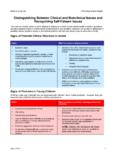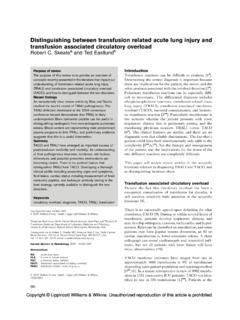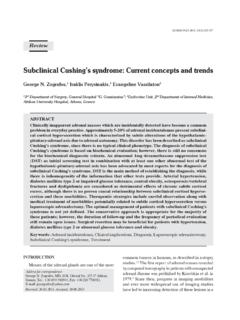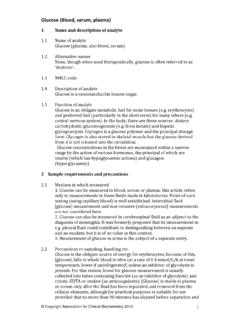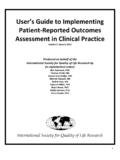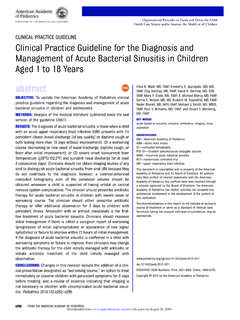Transcription of The Economic Argument for Disease Prevention ...
1 The Economic Argument for Disease Prevention : distinguishing between Value and Savings A Prevention Policy Paper Commissioned by Partnership for Prevention Steven H. Woolf, MD, MPH Professor of Family Medicine Virginia Commonwealth University Corinne G. Husten, MD, MPH Interim President Partnership for Prevention Lawrence S. Lewin, MBA Executive Consultant James S. Marks, MD, MPH Senior Vice President Robert Wood Johnson Foundation Jonathan E. Fielding, MD, MPH, MBA Director of Public Health and Health Officer Los Angeles County Department of Public Health Professor of Health Services and Pediatrics UCLA Schools of Public Health and Medicine Eduardo J. Sanchez, MD, MPH Vice President and Chief Medical Officer Blue Cross and Blue Shield of Texas The Economic Argument for Disease Prevention : distinguishing between Value and Savings 2 Executive Summary Unsustainable growth in medical spending has sparked interest in the question of whether Prevention saves money and could be the answer to the health care crisis.
2 But the question misses the point. What should matter (for both Prevention and treatment services) is value -- the health benefit per dollar invested. We discuss a package of effective clinical preventive services that improves health at a relatively low cost. Cost-effectiveness should also be examined for Disease care, the major driver of health spending. Health care spending can best be controlled by shifting investments from expensive low-value services to more cost-effective interventions. Note: The authors prepared this paper on behalf of the National Commission on Prevention Priorities (NCPP), which is convened by Partnership for Prevention . The NCPP guides Partnership for Prevention s work to assess the value of Prevention . Partnership for Prevention and the NCPP gratefully acknowledge support from WellPoint Foundation, Robert Wood Johnson Foundation, and Centers for Disease Control and Prevention . February 2009 The Economic Argument for Disease Prevention : distinguishing between Value and Savings 3 Introduction: The Problem and the Potential The rising costs of health care pose a formidable challenge for policymakers.
3 Health care already accounts for 16% of the gross domestic product (GDP) and is projected to increase to 25% by According to the Congressional Budget Office, spending on health care is likely to accelerate because of an aging population, a rising burden of chronic diseases, and higher costs for pharmaceuticals and other ,3 Increased spending will only exacerbate current stresses on the economy, employers, government programs, and the public. Many patients are foregoing health care, especially when they encounter higher medical costs. In addition, at a time when jobs and incomes are at risk,4,5 the recession is likely to accelerate the growth of the number of uninsured Americans. Because of the depth and gravity of this crisis, policymakers are under mounting pressure to solve it. An option of longstanding interest is Prevention interventions that prevent or delay the occurrence of the very diseases that drive these costs. There are three kinds of Prevention .
4 Primary Prevention can be accomplished by modifying unhealthy behaviors ( , smoking, physical inactivity), which cause many diseases and account for 38% of all deaths in the United States,6 administering immunizations to prevent infectious diseases, and reducing exposure to harmful environmental factors. Secondary Prevention can reduce the severity of diseases, such as cancer and heart Disease , through screening programs that detect the diseases or their risk factors at early stages, before they become symptomatic or disabling. Tertiary Prevention the effort to avoid or defer the complications of diseases after they have developed is the current focus of medical care. The health benefits of Prevention are intuitive it is wiser to prevent a Disease than to face its consequences at a more advanced stage but for many years policymakers, politicians, and professionals have also advanced the Economic Argument that Prevention saves money. Enthusiasm for Prevention has become prominent in health care reform discussions in Congress and was a theme during the 2008 presidential election.
5 Prevention is seen as the touchstone of a redesigned system focused on improving health Prevention advocates have emphasized that it will save money, arguing that Prevention is not only good for health but also a means to control ,9 The Trust for America s Health reported that Prevention programs could save the country more than $16 billion annually within five years, a return of $ per dollar The Commonwealth Fund estimated that reduced tobacco use and a decline in obesity would lower national health expenditures by $474 billion over 10 Whether Prevention does save money has been a running debate for decades. As long ago as 1986, in the book Is Prevention Better than Cure?, Rutgers economist Louise Russell argued that Prevention rarely reduces The issue resurfaced recently as policymakers embraced Prevention as a means for controlling spending. In October 2007, Russell reprised her message that Prevention rarely saves money in a report for the National Coalition for Health Care,13 and she did so again in a recent Cohen et al, in a February 2008 New England Journal of Medicine article directed at the 2008 presidential candidates, argued that Prevention is inherently no more cost effective than conventional medical In April 2008, an article in the same journal described primary Prevention as having the lowest potential among policy options for cost These findings were picked up by the news media.
6 An April 2008 The Economic Argument for Disease Prevention : distinguishing between Value and Savings 4 Washington Post article used the headline, Some candidates disagree, but studies show it s often cheaper to let people get sick. 17 An August 2008 Newsweek article warned that the conventional wisdom is wrong: preventive-care programs usually result in higher payouts, not lower ones. 18 An October 2008 New York Times op-ed called Prevention a campaign myth. 19 The purpose of this paper is to help make sense of these diverse perspectives, offer a clearer answer to the policymaker s question of whether and when Prevention saves money, and clarify what saving money really means. We argue for refocusing the question on value in health and Economic terms to properly weigh the merits of Prevention , and we review the evidence about the benefits and costs of Prevention . Finally, we note that the logic for emphasizing value is not just for Prevention but for all of health care.
7 A Closer Look at the Issues Reframing the Question: What Saving Money Really Means Health is a good, and goods whether they are national security, clean water, or a new car are not purchased to save money. They are purchased for the nonmonetary benefits they provide. Shoppers do not buy groceries to save money, but they do save money by shopping wisely. Resources can be stretched farther and more goods can ultimately be acquired by optimizing Economic value getting more per dollar spent. In Economic terms, value is the ratio between the cost of a service and its benefits. The metric that is used widely in health care is the cost-effectiveness (CE), or cost-utility ratio.* Some goods offer very high value by producing net savings, in which the cost of providing the service is exceeded by the savings it produces, but such services are rare. Some services cost relatively little per unit of health gain, but most of the $2 trillion spent annually on health care is for expensive tests and treatments that cost large amounts per unit of health gain.
8 Although services are said to have a reasonable CE if they cost less than $50,000 per quality-adjusted life year (QALY), payers routinely cover expensive treatments that cost more than $100,000 per QALY. For example, Medicare covers lung volume reduction surgery at a cost of $189,000 per Finding the occasional service that offers net savings is not the magic bullet for controlling health care spending. Through sheer volume, much more can be accomplished by limiting spending on expensive, relatively low-value services and shifting those dollars to high-value services that will make greater or comparable improvements in health at less cost (and may occasionally yield net savings). This reapportionment in spending offers the greatest opportunity to stretch the health care dollar and achieve greater health gains for the same expenditure. * The CE ratio is the cost of an intervention (numerator) divided by some measure of health gain (denominator), such as life years, quality-adjusted life years, or other health metrics.
9 The numerator and denominator create a counterintuitive relationship: exorbitant services have high CE ratios (low value), whereas the best buys (high value) have low CE ratios. Services that yield net savings have negative CE ratios because the numerator (cost of providing the service minus the savings it produces) is less than zero. The CE ratio is different for different services and even for the same service under different circumstances. The Economic Argument for Disease Prevention : distinguishing between Value and Savings 5 Thus, the proper question for Prevention and, ultimately, for all of health care is not whether it saves money but whether it offers good value on the dollar. 21 For a given Disease , which strategy Prevention , a new diagnostic test, or a better treatment offers the greatest benefit per unit cost? Finding the best ways to enhance health for the same cost is common sense, and it is common practice in other countries, such as Canada, the United Kingdom, France, and Japan.
10 The agencies that control health spending in these countries have made it a priority to study the CE of services and to eschew inefficient practices. They spend an average of 8-11% of their gross domestic product on health care (compared to 16% in the ) but rank higher than the on a variety of outcomes, such as infant mortality and life Why Economic Evaluations of Prevention Differ The public and policymakers receive mixed messages about the costs and benefits of Prevention . The least attractive outlooks come from short-view, narrowly focused analyses, such as the scoring performed by the Congressional Budget Office and many health plans, which tabulate the often sizable upfront costs of covering preventive services but ignore their subsequent payback over time. This approach creates sticker shock: according to one recent report, adding a package of preventive services would increase medical care costs by $ A more useful perspective emerges when the calculation considers the return on investment, such as CE research.


